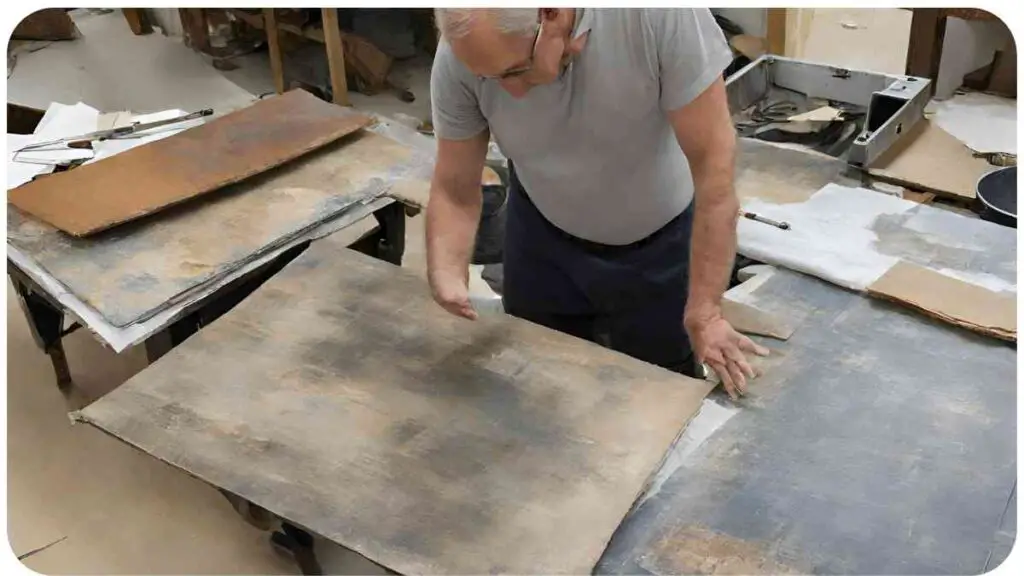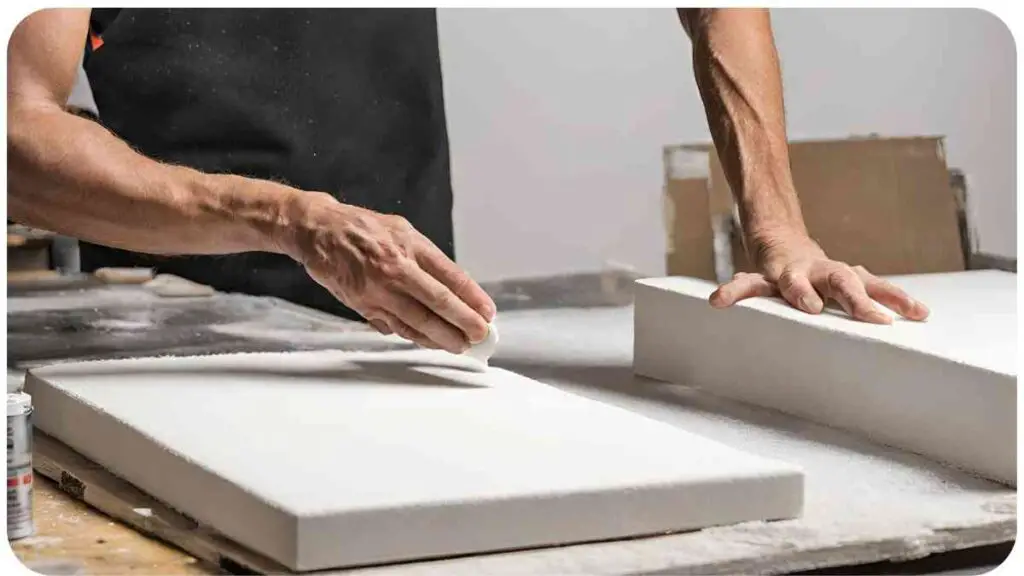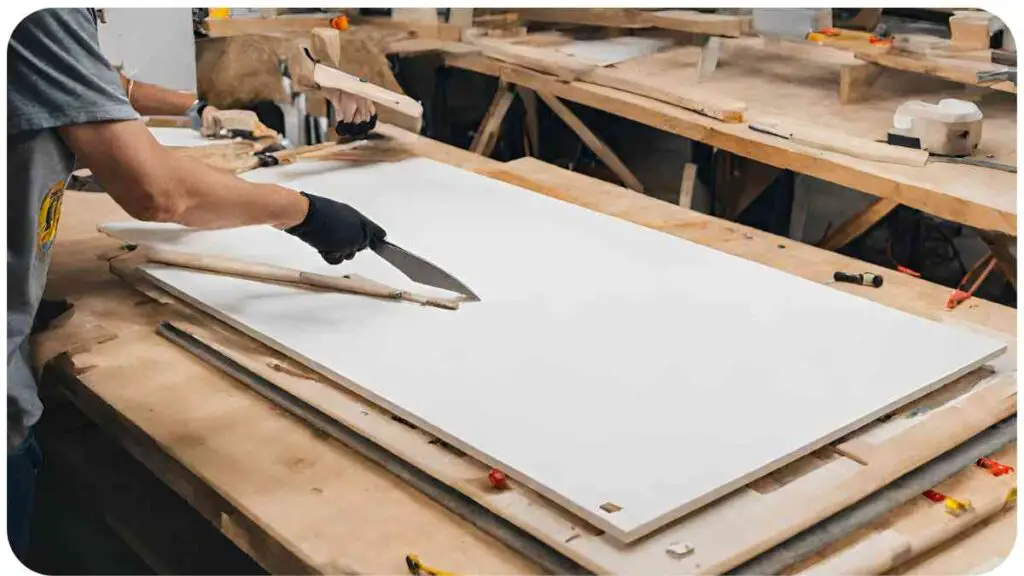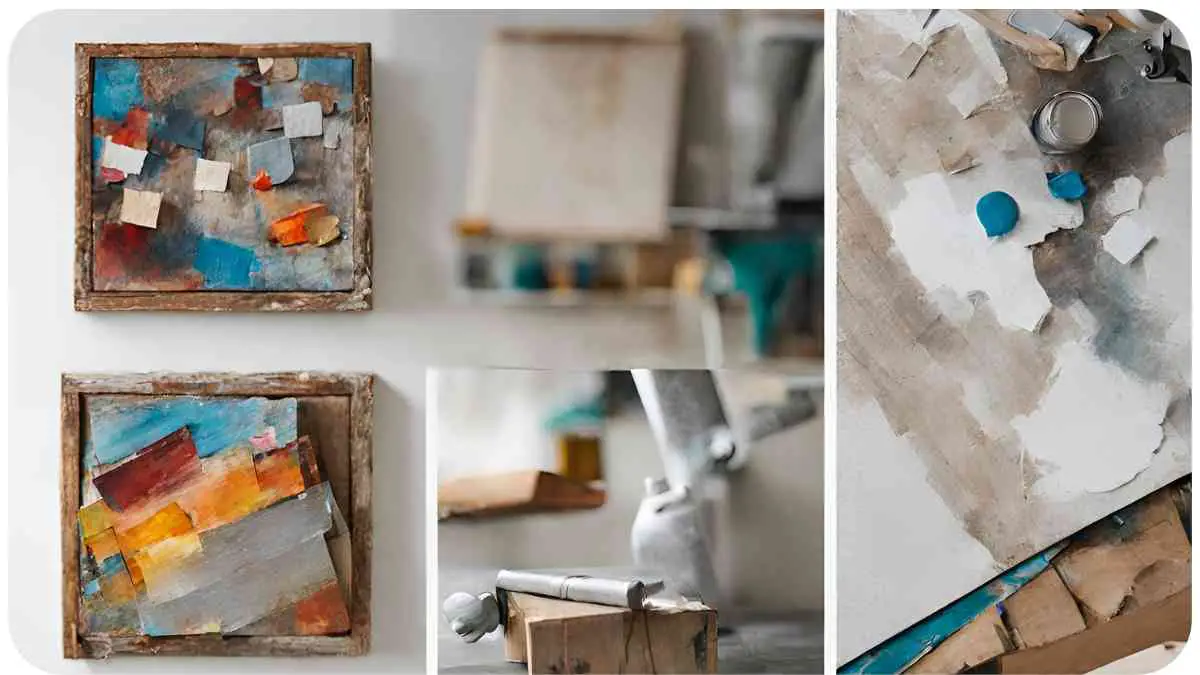Old canvases hold memories and stories within their layers of paint, but what do you do when you have canvases lying around that you no longer have use for? Instead of letting them collect dust in a corner, why not breathe new life into them?
In this guide, we’ll explore various techniques and tips for reusing old canvases creatively. Whether you’re an experienced artist or a novice looking to explore your creative side, there’s something for everyone in repurposing old canvases.
| Takeaways |
|---|
| 1. Old canvases can be resurfaced and repurposed to create new artwork, giving them a fresh lease on life. |
| 2. Base coating and painting over old canvases offers a simple yet effective method for reusing them in your artistic endeavors. |
| 3. With the right techniques, such as cleaning, priming, and sanding, old canvases can be prepared for reuse. |
| 4. Painting over existing artwork on old canvases allows for creative expression and experimentation with different colors and textures. |
| 5. Reusing old canvases not only fosters sustainability by reducing waste but also encourages creativity and innovation in the art community. |
2. Assessing the Condition of Old Canvases

Before diving into any reuse project, it’s essential to assess the condition of your old canvases. Here’s a quick checklist to help you determine whether a canvas is suitable for reuse:
When your canvas isn’t stretching as expected, here’s how to fix it. Understanding proper stretching techniques ensures your artwork remains taut, providing an ideal surface for your creativity to flourish.
| Condition | Description |
|---|---|
| Stretched | Is the canvas still tightly stretched, or does it sag? |
| Surface | Are there any tears, holes, or dents in the canvas? |
| Previous Artwork | How many layers of paint are already on the canvas? |
| Frame | Is the frame intact, or does it need repair? |
3. Cleaning and Preparing Old Canvases
Cleaning and preparing old canvases is a crucial step in the reuse process. Follow these steps to ensure your canvas is ready for its new life:
| Step | Description |
|---|---|
| Dusting | Use a soft brush to remove any dust or debris from the surface of the canvas. |
| Cleaning | Wipe the canvas gently with a damp cloth to remove dirt or stains. |
| Drying | Allow the canvas to air dry completely before proceeding. |
| Sanding | If the surface is rough or uneven, lightly sand it to create a smoother texture. |
By cleaning and preparing your old canvases, you’ll create a fresh canvas for your new artwork.
4. Priming and Re-Priming Canvases

Priming or re-priming old canvases is essential to ensure proper adhesion and longevity of your artwork. Here’s how to prime or re-prime your canvas effectively:
A dried-out paint marker can hinder your artistic flow, but fear not, troubleshooting tips are here. Learn how to revive your marker and continue creating vibrant masterpieces effortlessly.
| Step | Description |
|---|---|
| Primer Selection | Choose a suitable primer based on the type of paint you’ll be using (acrylic, oil, etc.). |
| Application | Apply the primer evenly across the surface of the canvas using a brush or roller. |
| Drying Time | Allow the primer to dry completely according to the manufacturer’s instructions. |
| Sanding (Optional) | For a smoother surface, lightly sand the primed canvas before painting. |
Priming your canvas not only enhances paint adhesion but also creates a barrier between the old paint layers and your new artwork.
5. Painting Over Existing Artwork
If your old canvas still has artwork on it that you’re not fond of, don’t fret! You can easily paint over existing artwork to create something entirely new. Here are some tips for painting over existing artwork:
| Tip | Description |
|---|---|
| Choose Light Colors | Start with light-colored paint to cover the existing artwork more effectively. |
| Multiple Layers | Apply multiple thin layers of paint rather than one thick layer to prevent cracking. |
| Texture | Experiment with different brush strokes and techniques to add texture to your new artwork. |
| Acrylic Gesso | Use acrylic gesso to prime the canvas before painting over existing artwork for better adhesion. |
By painting over existing artwork, you can transform your old canvas into a fresh masterpiece.
6. Incorporating Mixed Media Techniques
Mixing different mediums with paint can add depth and interest to your artwork. Here’s how you can incorporate mixed media techniques into your reused canvases:
Delve into the world of painting on wood with this comprehensive guide. Discover the compatibility of different paints and wood surfaces to unleash your creativity on this versatile canvas.
| Technique | Description |
|---|---|
| Collage | Use paper, fabric, or found objects to create collages on your canvas before painting. |
| Texture Paste | Apply texture paste to the canvas to create raised textures, then paint over it once dry. |
| Stenciling | Use stencils to add intricate designs or patterns to your canvas before or after painting. |
| Embellishments | Add embellishments like beads, sequins, or buttons to your artwork for added dimension. |
Mixed media techniques allow you to explore new avenues of creativity and add unique elements to your reused canvases.
7. Transforming Canvases into Collages
Collaging is a versatile technique that allows you to create dynamic and visually engaging artwork. Here’s how you can transform old canvases into collages:
| Step | Description |
|---|---|
| Gather Materials | Collect a variety of materials such as magazines, newspapers, fabric scraps, and photographs. |
| Arrange and Glue | Arrange the materials on the canvas in a pleasing composition, then glue them down using a suitable adhesive. |
| Paint Over | Once the collage is dry, you can paint over it to unify the elements and add your personal touch. |
| Seal | Seal the collage with a clear acrylic sealer to protect it and give it a finished look. |
Collaging allows you to repurpose old materials and create unique and eclectic artwork.
8. Resizing and Cutting Canvases

Sometimes, the size or shape of an old canvas might not fit your current artistic vision. In such cases, resizing or cutting the canvas can offer a solution. Here’s how to resize or cut old canvases effectively:
Understand why your chalk pastels are breaking and explore solutions with this insightful guide. Enhance your pastel techniques to create smooth, uninterrupted strokes in your artwork effortlessly.
| Step | Description |
|---|---|
| Marking | Use a ruler and pencil to mark the desired size or shape on the canvas. |
| Cutting | Carefully cut along the marked lines using a sharp utility knife or scissors. |
| Reinforcing | If necessary, reinforce the edges of the cut canvas with tape or additional canvas strips. |
| Finishing | Sand the edges of the cut canvas to smooth any rough edges before painting or priming. |
Resizing or cutting old canvases allows you to tailor them to your specific artistic needs and preferences.
9. Creating Textured Surfaces
Adding texture to your canvas can enhance the visual interest and tactile quality of your artwork. Here are some techniques for creating textured surfaces on old canvases:
| Technique | Description |
|---|---|
| Impasto | Apply thick layers of paint with a palette knife to create raised textures. |
| Mixed Media | Incorporate materials like sand, sawdust, or modeling paste into your paint to add texture. |
| Textured Gels | Use textured gels or mediums to create raised patterns or textures on the canvas surface. |
| Found Objects | Press objects like leaves, fabric, or mesh into wet paint to create impressions and textures. |
Experimenting with textured surfaces can add depth and dimension to your reused canvases, making them visually captivating.
10. Experimenting with Abstract Art
Abstract art offers endless possibilities for creativity and self-expression, making it an excellent choice for repurposing old canvases. Here are some tips for experimenting with abstract art:
| Tip | Description |
|---|---|
| Freeform Expression | Embrace spontaneity and let your intuition guide your brush strokes and color choices. |
| Layering | Build up layers of paint, textures, and patterns to create depth and complexity in your abstract compositions. |
| Play with Color | Explore different color combinations and experiment with contrasts, harmonies, and gradients. |
| Texture Exploration | Incorporate various techniques such as scraping, dripping, or splattering paint to add texture and movement to your artwork. |
Abstract art allows you to break free from traditional constraints and explore new possibilities with your old canvases.
11. Using Old Canvases for Practice
Old canvases provide the perfect opportunity for honing your artistic skills and trying out new techniques without the pressure of creating a finished masterpiece. Here’s how you can use old canvases for practice:
After completing a paint pour project, learn how to clean up effectively. Effortlessly remove spills and drips to maintain a tidy workspace, ensuring you’re ready for your next creative endeavor without any hassle.
| Practice Area | Description |
|---|---|
| Sketching | Use old canvases as sketching surfaces to practice composition, proportions, and perspective. |
| Color Mixing | Experiment with color mixing and blending techniques to develop your understanding of color theory. |
| Brushwork | Practice different brush strokes and techniques such as dry brushing, glazing, or stippling. |
| Experimentation | Try out new mediums, styles, or subject matter to expand your artistic repertoire and discover your unique voice. |
Using old canvases for practice allows you to refine your skills and build confidence as an artist.
12. Displaying Reused Canvases
Once you’ve transformed your old canvases into new works of art, it’s time to showcase them in a way that highlights their beauty and uniqueness. Here are some creative ideas for displaying reused canvases:
| Display Idea | Description |
|---|---|
| Gallery Wall | Create a gallery wall by arranging multiple reused canvases of varying sizes and styles together. |
| Floating Shelves | Display individual canvases on floating shelves to give them a modern and minimalist look. |
| Rotating Display | Rotate your reused canvases periodically to keep your display fresh and dynamic. |
| Mixed Media Installations | Incorporate other elements such as framed photographs, sculptures, or plants into your display for added interest. |
By thoughtfully displaying your reused canvases, you can turn your space into a curated art gallery that reflects your personal style and creativity.
13. Sustainability and Environmental Impact
Repurposing old canvases isn’t just a creative endeavor—it’s also an eco-friendly choice that contributes to sustainability. Here’s how reusing old canvases can benefit the environment:
| Benefit | Description |
|---|---|
| Reduces Waste | Repurposing old canvases helps divert materials from landfills, reducing environmental impact. |
| Conserves Resources | By reusing existing materials, fewer resources are consumed in the production of new canvases. |
| Encourages Creativity | Reusing old canvases encourages creativity and innovation while promoting a culture of resourcefulness. |
| Promotes Awareness | By showcasing reused canvases, artists can raise awareness about the importance of sustainable practices in the art community. |
By embracing reuse and sustainability in your artistic practice, you can make a positive impact on the environment while creating meaningful artwork.
14. Conclusion
Reusing old canvases is not only a practical way to breathe new life into forgotten artwork but also a sustainable and environmentally friendly practice. By following the tips and techniques outlined in this guide, you can unleash your creativity and transform old canvases into captivating works of art.
From painting over existing artwork to experimenting with mixed media techniques, the possibilities for reusing old canvases are endless. Whether you’re a seasoned artist looking for a new challenge or a beginner eager to explore your artistic talents, repurposing old canvases offers a wealth of opportunities for creative expression.
Moreover, by embracing reuse and sustainability in your artistic practice, you can make a positive impact on the environment and inspire others to adopt similar practices. Through thoughtful display and promotion of reused canvases, you can raise awareness about the importance of sustainable practices in the art community and beyond.
So, the next time you find yourself with old canvases gathering dust, don’t hesitate to pick up your brushes and get creative. With a little imagination and ingenuity, you can turn those forgotten canvases into beautiful artworks that tell new stories and inspire others.
Happy creating!
Further Reading
- How to Resurface Old Canvas Paintings to Create New Artwork: Learn techniques for resurfacing old canvas paintings to give them new life and create fresh artwork.
- How to Reuse and Base Coat and Paint Over an Old Canvas: Discover methods for reusing old canvases by base coating and painting over them to create new masterpieces.
- An Easy Way to Repurpose Old Canvas Art: Explore a simple and effective approach to repurposing old canvas art for new creative projects.
FAQs
How can I determine if an old canvas is suitable for reuse?
- Assess the condition of the canvas, including its tightness, surface integrity, and previous artwork layers.
What are some techniques for preparing old canvases for reuse?
- Dusting, cleaning, priming, and sanding are essential steps in preparing old canvases for reuse.
Is it possible to paint over existing artwork on old canvases?
- Yes, you can paint over existing artwork on old canvases by starting with light colors, applying multiple layers, and experimenting with textures.
What are some creative ways to repurpose old canvases?
- You can transform old canvases into collages, experiment with mixed media techniques, resize or cut them, or use them for practice.
How can reusing old canvases contribute to sustainability?
- Repurposing old canvases reduces waste, conserves resources, encourages creativity, and promotes awareness of sustainable practices in the art community.

Hellen James is the creator of Unified Crafts and has been crafting since she was a kid accompanied by her mom to the craft store, where she was free to choose whatever ignited her imagination.

